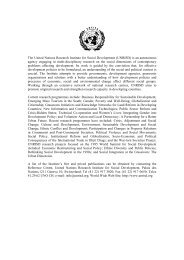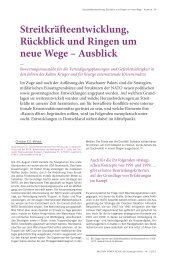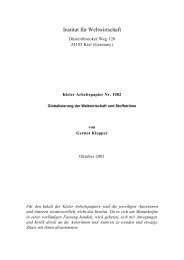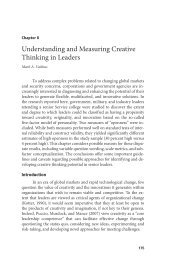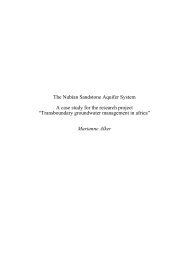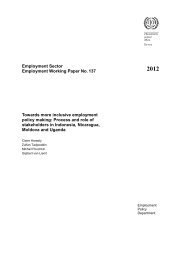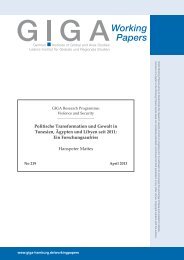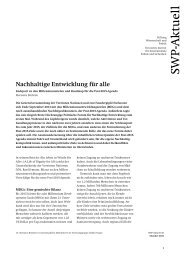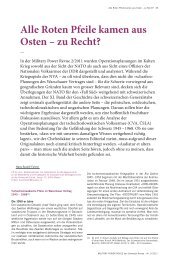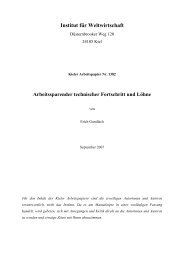- Page 1 and 2:
EU LAND MARKETSAND THECOMMON AGRICU
- Page 3 and 4:
CONTENTSAcknowledgements...........
- Page 5 and 6:
Empirical studies on land rents....
- Page 7 and 8:
Figure 34. Regional differences in
- Page 9:
Figure 80. Effect of the regional S
- Page 12 and 13:
LIST OF ABBREVIATIONSACs Autonomous
- Page 14 and 15:
iv | EXECUTIVE SUMMARYasset values
- Page 16 and 17:
vi | EXECUTIVE SUMMARYbut their eff
- Page 18 and 19:
viii | EXECUTIVE SUMMARYtends to be
- Page 20 and 21: x | EXECUTIVE SUMMARYsignificance o
- Page 22 and 23: xii | EXECUTIVE SUMMARYThe impact o
- Page 25 and 26: 1. INTRODUCTIONThe establishment of
- Page 27 and 28: 2. CONCEPTUAL FRAMEWORKSince the fo
- Page 29 and 30: EU LAND MARKETS AND THE COMMON AGRI
- Page 31 and 32: EU LAND MARKETS AND THE COMMON AGRI
- Page 33 and 34: EU LAND MARKETS AND THE COMMON AGRI
- Page 35 and 36: EU LAND MARKETS AND THE COMMON AGRI
- Page 37 and 38: EU LAND MARKETS AND THE COMMON AGRI
- Page 39 and 40: EU LAND MARKETS AND THE COMMON AGRI
- Page 41 and 42: EU LAND MARKETS AND THE COMMON AGRI
- Page 43 and 44: EU LAND MARKETS AND THE COMMON AGRI
- Page 45 and 46: EU LAND MARKETS AND THE COMMON AGRI
- Page 47 and 48: EU LAND MARKETS AND THE COMMON AGRI
- Page 49 and 50: EU LAND MARKETS AND THE COMMON AGRI
- Page 51 and 52: EU LAND MARKETS AND THE COMMON AGRI
- Page 53 and 54: EU LAND MARKETS AND THE COMMON AGRI
- Page 55 and 56: EU LAND MARKETS AND THE COMMON AGRI
- Page 57 and 58: EU LAND MARKETS AND THE COMMON AGRI
- Page 59 and 60: EU LAND MARKETS AND THE COMMON AGRI
- Page 61 and 62: EU LAND MARKETS AND THE COMMON AGRI
- Page 63 and 64: EU LAND MARKETS AND THE COMMON AGRI
- Page 65 and 66: EU LAND MARKETS AND THE COMMON AGRI
- Page 67 and 68: EU LAND MARKETS AND THE COMMON AGRI
- Page 69: EU LAND MARKETS AND THE COMMON AGRI
- Page 73 and 74: EU LAND MARKETS AND THE COMMON AGRI
- Page 75 and 76: EU LAND MARKETS AND THE COMMON AGRI
- Page 77 and 78: EU LAND MARKETS AND THE COMMON AGRI
- Page 79 and 80: EU LAND MARKETS AND THE COMMON AGRI
- Page 81 and 82: EU LAND MARKETS AND THE COMMON AGRI
- Page 83 and 84: EU LAND MARKETS AND THE COMMON AGRI
- Page 85 and 86: EU LAND MARKETS AND THE COMMON AGRI
- Page 87 and 88: EU LAND MARKETS AND THE COMMON AGRI
- Page 89 and 90: EU LAND MARKETS AND THE COMMON AGRI
- Page 91 and 92: EU LAND MARKETS AND THE COMMON AGRI
- Page 93 and 94: EU LAND MARKETS AND THE COMMON AGRI
- Page 95 and 96: EU LAND MARKETS AND THE COMMON AGRI
- Page 97 and 98: EU LAND MARKETS AND THE COMMON AGRI
- Page 99 and 100: EU LAND MARKETS AND THE COMMON AGRI
- Page 101 and 102: EU LAND MARKETS AND THE COMMON AGRI
- Page 103 and 104: EU LAND MARKETS AND THE COMMON AGRI
- Page 105 and 106: EU LAND MARKETS AND THE COMMON AGRI
- Page 107 and 108: EU LAND MARKETS AND THE COMMON AGRI
- Page 109 and 110: EU LAND MARKETS AND THE COMMON AGRI
- Page 111 and 112: EU LAND MARKETS AND THE COMMON AGRI
- Page 113 and 114: EU LAND MARKETS AND THE COMMON AGRI
- Page 115 and 116: EU LAND MARKETS AND THE COMMON AGRI
- Page 117 and 118: EU LAND MARKETS AND THE COMMON AGRI
- Page 119 and 120: EU LAND MARKETS AND THE COMMON AGRI
- Page 121 and 122:
EU LAND MARKETS AND THE COMMON AGRI
- Page 123 and 124:
EU LAND MARKETS AND THE COMMON AGRI
- Page 125 and 126:
EU LAND MARKETS AND THE COMMON AGRI
- Page 127 and 128:
EU LAND MARKETS AND THE COMMON AGRI
- Page 129 and 130:
EU LAND MARKETS AND THE COMMON AGRI
- Page 131 and 132:
EU LAND MARKETS AND THE COMMON AGRI
- Page 133 and 134:
EU LAND MARKETS AND THE COMMON AGRI
- Page 135 and 136:
EU LAND MARKETS AND THE COMMON AGRI
- Page 137 and 138:
EU LAND MARKETS AND THE COMMON AGRI
- Page 139 and 140:
EU LAND MARKETS AND THE COMMON AGRI
- Page 141 and 142:
EU LAND MARKETS AND THE COMMON AGRI
- Page 143 and 144:
EU LAND MARKETS AND THE COMMON AGRI
- Page 145 and 146:
EU LAND MARKETS AND THE COMMON AGRI
- Page 147 and 148:
EU LAND MARKETS AND THE COMMON AGRI
- Page 149 and 150:
EU LAND MARKETS AND THE COMMON AGRI
- Page 151 and 152:
EU LAND MARKETS AND THE COMMON AGRI
- Page 153 and 154:
EU LAND MARKETS AND THE COMMON AGRI
- Page 155 and 156:
EU LAND MARKETS AND THE COMMON AGRI
- Page 157 and 158:
EU LAND MARKETS AND THE COMMON AGRI
- Page 159 and 160:
EU LAND MARKETS AND THE COMMON AGRI
- Page 161 and 162:
8. IMPACT OF THE SPS ON LANDMARKETS
- Page 163 and 164:
EU LAND MARKETS AND THE COMMON AGRI
- Page 165 and 166:
EU LAND MARKETS AND THE COMMON AGRI
- Page 167 and 168:
EU LAND MARKETS AND THE COMMON AGRI
- Page 169 and 170:
EU LAND MARKETS AND THE COMMON AGRI
- Page 171 and 172:
EU LAND MARKETS AND THE COMMON AGRI
- Page 173 and 174:
EU LAND MARKETS AND THE COMMON AGRI
- Page 175 and 176:
EU LAND MARKETS AND THE COMMON AGRI
- Page 177 and 178:
EU LAND MARKETS AND THE COMMON AGRI
- Page 179 and 180:
EU LAND MARKETS AND THE COMMON AGRI
- Page 181 and 182:
EU LAND MARKETS AND THE COMMON AGRI
- Page 183 and 184:
EU LAND MARKETS AND THE COMMON AGRI
- Page 185 and 186:
EU LAND MARKETS AND THE COMMON AGRI
- Page 187 and 188:
EU LAND MARKETS AND THE COMMON AGRI
- Page 189 and 190:
EU LAND MARKETS AND THE COMMON AGRI
- Page 191 and 192:
EU LAND MARKETS AND THE COMMON AGRI
- Page 193 and 194:
EU LAND MARKETS AND THE COMMON AGRI
- Page 195 and 196:
EU LAND MARKETS AND THE COMMON AGRI
- Page 197 and 198:
EU LAND MARKETS AND THE COMMON AGRI
- Page 199 and 200:
EU LAND MARKETS AND THE COMMON AGRI
- Page 201 and 202:
EU LAND MARKETS AND THE COMMON AGRI
- Page 203 and 204:
EU LAND MARKETS AND THE COMMON AGRI
- Page 205 and 206:
EU LAND MARKETS AND THE COMMON AGRI
- Page 207 and 208:
EU LAND MARKETS AND THE COMMON AGRI
- Page 209 and 210:
EU LAND MARKETS AND THE COMMON AGRI
- Page 211 and 212:
EU LAND MARKETS AND THE COMMON AGRI
- Page 213 and 214:
EU LAND MARKETS AND THE COMMON AGRI
- Page 215 and 216:
EU LAND MARKETS AND THE COMMON AGRI
- Page 217 and 218:
BIBLIOGRAPHYAbler, D. (2001), “El
- Page 219 and 220:
EU LAND MARKETS AND THE COMMON AGRI
- Page 221 and 222:
EU LAND MARKETS AND THE COMMON AGRI
- Page 223 and 224:
EU LAND MARKETS AND THE COMMON AGRI
- Page 225 and 226:
EU LAND MARKETS AND THE COMMON AGRI
- Page 227 and 228:
EU LAND MARKETS AND THE COMMON AGRI
- Page 229 and 230:
EU LAND MARKETS AND THE COMMON AGRI
- Page 231 and 232:
EU LAND MARKETS AND THE COMMON AGRI
- Page 233 and 234:
EU LAND MARKETS AND THE COMMON AGRI
- Page 235 and 236:
EU LAND MARKETS AND THE COMMON AGRI
- Page 237 and 238:
EU LAND MARKETS AND THE COMMON AGRI
- Page 239 and 240:
EU LAND MARKETS AND THE COMMON AGRI
- Page 241 and 242:
EU LAND MARKETS AND THE COMMON AGRI
- Page 243 and 244:
EU LAND MARKETS AND THE COMMON AGRI
- Page 245 and 246:
EU LAND MARKETS AND THE COMMON AGRI
- Page 247 and 248:
EU LAND MARKETS AND THE COMMON AGRI
- Page 249 and 250:
EU LAND MARKETS AND THE COMMON AGRI
- Page 251 and 252:
EU LAND MARKETS AND THE COMMON AGRI
- Page 253 and 254:
EU LAND MARKETS AND THE COMMON AGRI
- Page 255 and 256:
EU LAND MARKETS AND THE COMMON AGRI
- Page 257 and 258:
EU LAND MARKETS AND THE COMMON AGRI
- Page 259 and 260:
EU LAND MARKETS AND THE COMMON AGRI
- Page 261 and 262:
EU LAND MARKETS AND THE COMMON AGRI
- Page 263 and 264:
EU LAND MARKETS AND THE COMMON AGRI
- Page 265 and 266:
EU LAND MARKETS AND THE COMMON AGRI
- Page 267 and 268:
EU LAND MARKETS AND THE COMMON AGRI
- Page 269 and 270:
EU LAND MARKETS AND THE COMMON AGRI
- Page 271 and 272:
EU LAND MARKETS AND THE COMMON AGRI
- Page 273 and 274:
EU LAND MARKETS AND THE COMMON AGRI
- Page 275 and 276:
EU LAND MARKETS AND THE COMMON AGRI
- Page 277 and 278:
EU LAND MARKETS AND THE COMMON AGRI
- Page 279 and 280:
EU LAND MARKETS AND THE COMMON AGRI
- Page 281 and 282:
EU LAND MARKETS AND THE COMMON AGRI
- Page 283 and 284:
EU LAND MARKETS AND THE COMMON AGRI
- Page 285 and 286:
EU LAND MARKETS AND THE COMMON AGRI
- Page 287 and 288:
EU LAND MARKETS AND THE COMMON AGRI
- Page 289 and 290:
EU LAND MARKETS AND THE COMMON AGRI
- Page 291 and 292:
EU LAND MARKETS AND THE COMMON AGRI
- Page 293 and 294:
EU LAND MARKETS AND THE COMMON AGRI
- Page 295 and 296:
EU LAND MARKETS AND THE COMMON AGRI
- Page 297 and 298:
EU LAND MARKETS AND THE COMMON AGRI
- Page 299 and 300:
EU LAND MARKETS AND THE COMMON AGRI
- Page 301 and 302:
EU LAND MARKETS AND THE COMMON AGRI
- Page 303 and 304:
EU LAND MARKETS AND THE COMMON AGRI
- Page 305 and 306:
EU LAND MARKETS AND THE COMMON AGRI
- Page 307 and 308:
APPENDIX 1. LITERATURE REVIEWIntrod
- Page 309 and 310:
EU LAND MARKETS AND THE COMMON AGRI
- Page 311 and 312:
EU LAND MARKETS AND THE COMMON AGRI
- Page 313 and 314:
EU LAND MARKETS AND THE COMMON AGRI
- Page 315 and 316:
EU LAND MARKETS AND THE COMMON AGRI
- Page 317 and 318:
EU LAND MARKETS AND THE COMMON AGRI
- Page 319 and 320:
EU LAND MARKETS AND THE COMMON AGRI
- Page 321 and 322:
EU LAND MARKETS AND THE COMMON AGRI
- Page 323 and 324:
EU LAND MARKETS AND THE COMMON AGRI
- Page 325 and 326:
EU LAND MARKETS AND THE COMMON AGRI
- Page 327 and 328:
EU LAND MARKETS AND THE COMMON AGRI
- Page 329 and 330:
EU LAND MARKETS AND THE COMMON AGRI
- Page 331 and 332:
EU LAND MARKETS AND THE COMMON AGRI
- Page 333 and 334:
EU LAND MARKETS AND THE COMMON AGRI
- Page 335 and 336:
EU LAND MARKETS AND THE COMMON AGRI
- Page 337 and 338:
EU LAND MARKETS AND THE COMMON AGRI
- Page 339 and 340:
EU LAND MARKETS AND THE COMMON AGRI
- Page 341 and 342:
EU LAND MARKETS AND THE COMMON AGRI
- Page 343 and 344:
EU LAND MARKETS AND THE COMMON AGRI
- Page 345 and 346:
EU LAND MARKETS AND THE COMMON AGRI
- Page 347 and 348:
EU LAND MARKETS AND THE COMMON AGRI
- Page 349 and 350:
EU LAND MARKETS AND THE COMMON AGRI
- Page 351 and 352:
EU LAND MARKETS AND THE COMMON AGRI
- Page 353 and 354:
EU LAND MARKETS AND THE COMMON AGRI
- Page 355 and 356:
EU LAND MARKETS AND THE COMMON AGRI
- Page 357 and 358:
EU LAND MARKETS AND THE COMMON AGRI
- Page 359 and 360:
EU LAND MARKETS AND THE COMMON AGRI
- Page 361 and 362:
EU LAND MARKETS AND THE COMMON AGRI
- Page 363 and 364:
EU LAND MARKETS AND THE COMMON AGRI
- Page 365 and 366:
EU LAND MARKETS AND THE COMMON AGRI
- Page 367:
EU LAND MARKETS AND THE COMMON AGRI




